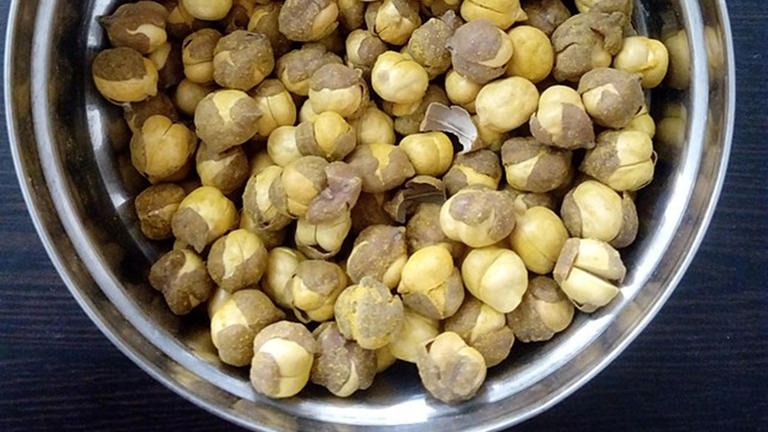Here’s what roasted chana does to your body (Source: Wikimedia Commons)
Roasted chana is a nutrient-dense snack, providing essential nutrients like protein, fibre, vitamins, and minerals. But taking a leaf out of our What Happens to Your Body series, would you fathom what would happen if you ate a protein-rich diet with roasted chana every day?
Kavya Naidu, a clinical nutritionist, said roasted chana provides many health benefits and its daily consumption can work wonders for the body. “It should be included in every individual’s diet. Its combination of taste and health benefits makes it an excellent choice for a wholesome snack.”
According to Dr Somnath Gupta, senior consultant physician, Yashoda Hospitals, Hyderabad, the protein content in roasted chana supports muscle repair and growth, contributing to overall muscle health.
“The fibre content aids in digestion, promoting a healthy digestive system and helping maintain a regular bowel movement. Roasted chana contains vitamins (e.g., B vitamins) and minerals (e.g., iron, magnesium) that contribute to overall well-being and support various bodily functions,” said Dr Gupta.
Dr Dilip Gude, senior consultant physician, Yashoda Hospitals, Hyderabad mentioned that chickpea lentils are not only a great source of dietary (natural) fibre, but they are also protein-rich and have a low glycemic index.
“The absence of cholesterol, the abundance of vitamin B complex, vitamin C, iron, selenium, manganese, calcium, copper, zinc and potassium (coupled with very less sodium) are known to help prevent heart disease. These can also decrease homocysteine and regulate and ensure good blood flow to vital organs by reducing blood clot formation. The magnesium content is optimum as well and helps with electrical activity of the heart (rhythm). These also help in regulating blood pressure,” said Dr Gude.
The fibre and protein in roasted chana can also help with satiety, potentially aiding in weight management by promoting a feeling of fullness. However, it’s important to note that roasted chana is calorie-dense. “Excessive consumption may contribute to caloric intake surpassing energy needs, potentially leading to weight gain,” said Dr Gupta.
Increased fibre prevents constipation, prevents the postprandial rise of sugars, and thereby helps in controlling diabetes as well. “These appetite suppressant characteristics from good plant protein intake also help in weight management. Pre-probiotic contents of chickpeas help in promoting gut health,” said Dr Gude.
Consume a variety of plant-based diets (Source: Getty Images/Thinkstock)
While a good plant-based protein source, roasted chana lacks certain amino acids found in complete protein sources, so it’s advisable to diversify protein intake for a well-rounded amino acid profile. According to Dr Gupta, excessive fibre intake from roasted chana may cause digestive discomfort, including bloating and gas, emphasising the need for moderation.
“Roasted chana contains purines, which can be a concern for individuals predisposed to gout. High purine levels may contribute to uric acid accumulation and subsequent joint issues. While roasted chana offers health benefits, moderation is crucial to avoid potential drawbacks associated with overconsumption,” said Dr Gupta.
What to keep in mind?
Some may experience few side effects like diarrhoea, bloating, intestinal gas, and allergies if consumed in large quantities. “Do not consume more than 100gm of roasted chana. Portion control is crucial, as excessive consumption can lead to side effects. Always remember moderation is the key,” said Naidu.
Including a variety of foods in the diet ensures a balanced intake of nutrients, addressing potential deficiencies that may arise from relying solely on one type of food. “Individuals with specific health concerns or dietary restrictions should consider consulting healthcare professionals or nutritionists for personalised advice tailored to their unique needs,” said Dr Gupta.
Naidu explained that a well-balanced diet includes other protein sources like legumes, dairy products, meat, and eggs. Add vegetables, fruits, healthy fats, and fibre into the diet.





